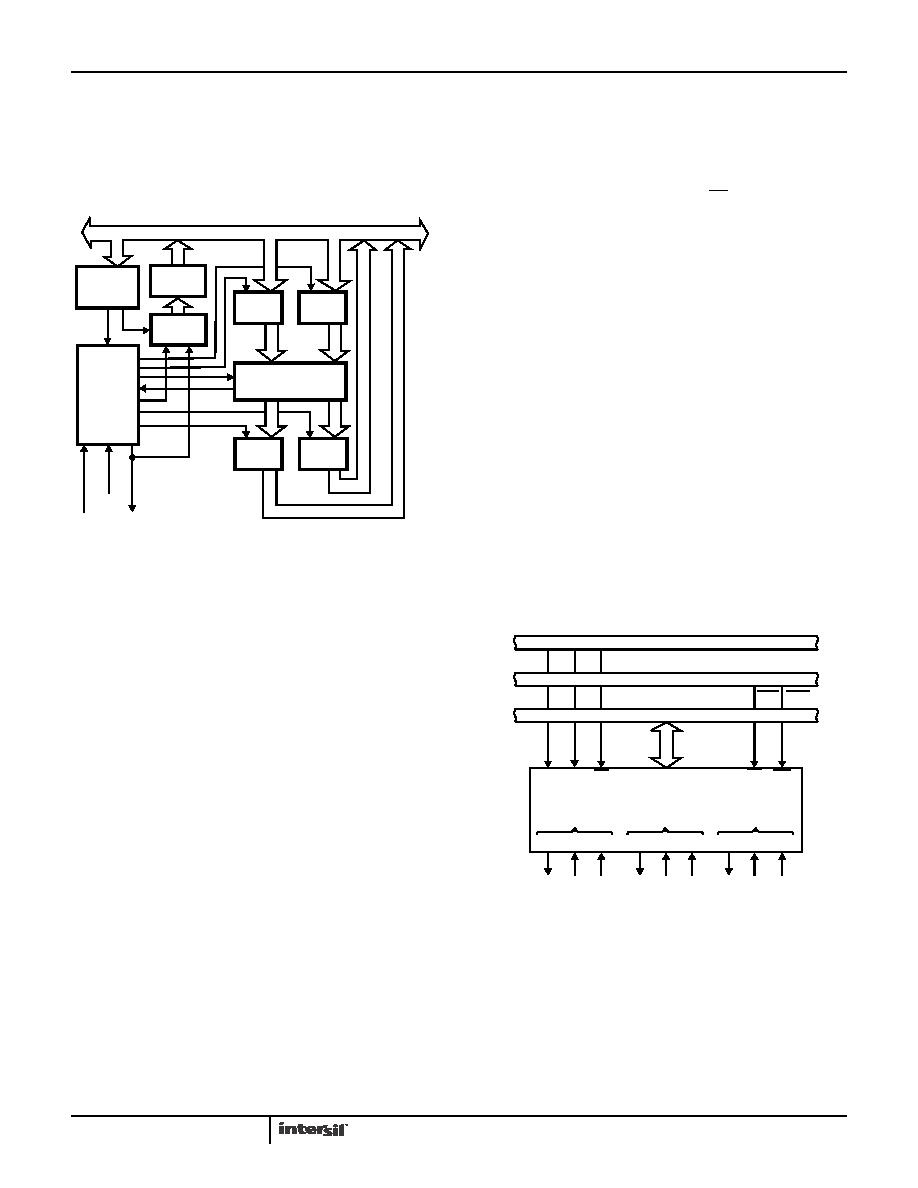- 您現(xiàn)在的位置:買(mǎi)賣(mài)IC網(wǎng) > PDF目錄9457 > CS82C5496 (Intersil)IC OSC PROG TIMER 8MHZ 28PLCC PDF資料下載
參數(shù)資料
| 型號(hào): | CS82C5496 |
| 廠商: | Intersil |
| 文件頁(yè)數(shù): | 20/22頁(yè) |
| 文件大?。?/td> | 0K |
| 描述: | IC OSC PROG TIMER 8MHZ 28PLCC |
| 標(biāo)準(zhǔn)包裝: | 750 |
| 類(lèi)型: | 可編程計(jì)時(shí)器 |
| 頻率: | 8MHz |
| 電源電壓: | 4.5 V ~ 5.5 V |
| 電流 - 電源: | 10mA |
| 工作溫度: | 0°C ~ 70°C |
| 封裝/外殼: | 28-LCC(J 形引線) |
| 包裝: | 帶卷 (TR) |
| 供應(yīng)商設(shè)備封裝: | 28-PLCC(11.51x11.51) |
| 安裝類(lèi)型: | 表面貼裝 |
第1頁(yè)第2頁(yè)第3頁(yè)第4頁(yè)第5頁(yè)第6頁(yè)第7頁(yè)第8頁(yè)第9頁(yè)第10頁(yè)第11頁(yè)第12頁(yè)第13頁(yè)第14頁(yè)第15頁(yè)第16頁(yè)第17頁(yè)第18頁(yè)第19頁(yè)當(dāng)前第20頁(yè)第21頁(yè)第22頁(yè)

7
82C54
The status register, shown in the figure, when latched,
contains the current contents of the Control Word Register
and status of the output and null count flag. (See detailed
explanation of the Read-Back command.)
The actual counter is labeled CE (for Counting Element). It is
a 16-bit presettable synchronous down counter.
OLM and OLL are two 8-bit latches. OL stands for “Output
Latch”; the subscripts M and L for “Most significant byte” and
“Least significant byte”, respectively. Both are normally referred
to as one unit and called just OL. These latches normally
“follow” the CE, but if a suitable Counter Latch Command is
sent to the 82C54, the latches “l(fā)atch” the present count until
read by the CPU and then return to “following” the CE. One
latch at a time is enabled by the counter’s Control Logic to drive
the internal bus. This is how the 16-bit Counter communicates
over the 8-bit internal bus. Note that the CE itself cannot be
read; whenever you read the count, it is the OL that is being
read.
Similarly, there are two 8-bit registers called CRM and CRL (for
“Count Register”). Both are normally referred to as one unit and
called just CR. When a new count is written to the Counter, the
count is stored in the CR and later transferred to the CE. The
Control Logic allows one register at a time to be loaded from
the internal bus. Both bytes are transferred to the CE
simultaneously. CRM and CRL are cleared when the Counter
is programmed for one byte counts (either most significant byte
only or least significant byte only) the other byte will be zero.
Note that the CE cannot be written into; whenever a count is
written, it is written into the CR.
The Control Logic is also shown in the diagram. CLK n,
GATE n, and OUT n are all connected to the outside world
through the Control Logic.
82C54 System Interface
The 82C54 is treated by the system software as an array of
peripheral I/O ports; three are counters and the fourth is a
control register for MODE programming.
Basically, the select inputs A0, A1 connect to the A0, A1
address bus signals of the CPU. The CS can be derived
directly from the address bus using a linear select method or
it can be connected to the output of a decoder.
Operational Description
General
After power-up, the state of the 82C54 is undefined. The
Mode, count value, and output of all Counters are undefined.
How each Counter operates is determined when it is
programmed. Each Counter must be programmed before it
can be used. Unused counters need not be programmed.
Programming the 82C54
Counters are programmed by writing a Control Word and
then an initial count.
All Control Words are written into the Control Word Register,
which is selected when A1, A0 = 11. The Control Word
specifies which Counter is being programmed.
By contrast, initial counts are written into the Counters, not
the Control Word Register. The A1, A0 inputs are used to
select the Counter to be written into. The format of the initial
count is determined by the Control Word used.
Write Operations
The programming procedure for the 82C54 is very flexible.
Only two conventions need to be remembered:
1. For Each Counter, the Control Word must be written
before the initial count is written.
2. The initial count must follow the count format specified in the
Control Word (least significant byte only, most significant
byte only, or least significant byte and then most significant
byte).
INTERNAL BUS
CONTROL
LOGIC
CONTROL
WORD
REGISTER
STATUS
LATCH
STATUS
REGISTER
CLK n
GATE n
OUT n
OLM
OLL
CE
CRM
CRL
FIGURE 3. COUNTER INTERNAL BLOCK DIAGRAM
ADDRESS BUS (16)
CONTROL BUS
DATA BUS (8)
I/OR I/OW
WR
RD
CS
A0
A1
A0
8
COUNTER
0
OUT GATE CLK
COUNTER
1
COUNTER
2
OUT GATE CLK
D0 - D7
82C54
FIGURE 4. COUNTER INTERNAL BLOCK DIAGRAM
相關(guān)PDF資料 |
PDF描述 |
|---|---|
| MAX1271BENG+ | IC ADC 12BIT 8CH 24-DIP |
| M83723/75W14157 | CONN PLUG 15POS STRAIGHT W/SCKT |
| MAX1270BENG+ | IC ADC 12BIT SERIAL 24-DIP |
| VI-B7Y-MY-S | CONVERTER MOD DC/DC 3.3V 33W |
| MAX188CEPP+ | IC ADC 12BIT SERIAL 20-DIP |
相關(guān)代理商/技術(shù)參數(shù) |
參數(shù)描述 |
|---|---|
| CS82C5496S2485 | 制造商:Rochester Electronics LLC 功能描述:- Bulk |
| CS82C5496S5001 | 制造商:Rochester Electronics LLC 功能描述:- Bulk |
| CS82C54S2075 | 制造商:Rochester Electronics LLC 功能描述:- Bulk |
| CS82C54Z | 功能描述:計(jì)時(shí)器和支持產(chǎn)品 PERIPH PRG-CNTR 5V 8MHZ 28PLCC COM RoHS:否 制造商:Micrel 類(lèi)型:Standard 封裝 / 箱體:SOT-23 內(nèi)部定時(shí)器數(shù)量:1 電源電壓-最大:18 V 電源電壓-最小:2.7 V 最大功率耗散: 最大工作溫度:+ 85 C 最小工作溫度:- 40 C 封裝:Reel |
| CS82C54Z | 制造商:Intersil Corporation 功能描述:CMOS PROGRAMMABLE INTERVAL TIMER 制造商:Intersil Corporation 功能描述:CMOS, PROGRAMMABLE INTERVAL TIMER |
發(fā)布緊急采購(gòu),3分鐘左右您將得到回復(fù)。